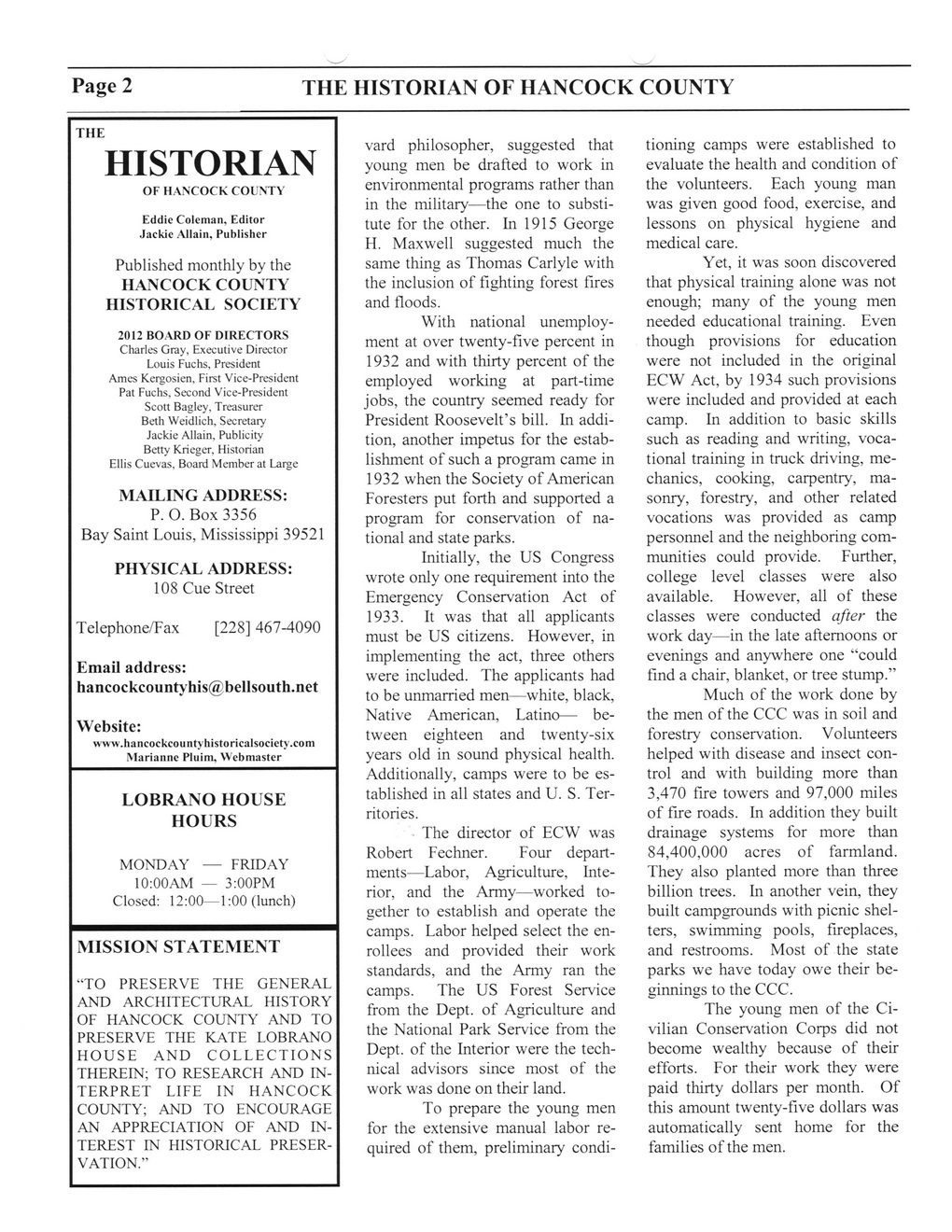This text was obtained via automated optical character recognition.
It has not been edited and may therefore contain several errors.
Page 2 THE HISTORIAN OF HANCOCK COUNTY THE HISTORIAN OF HANCOCK COUNTY Eddie Coleman, Editor Jackie Allain, Publisher Published monthly by the HANCOCK COUNTY HISTORICAL SOCIETY 2012 BOARD OF DIRECTORS Charles Gray, Executive Director Louis Fuchs, President Ames Kergosien, First Vice-President Pat Fuchs, Second Vice-President Scott Bagley, Treasurer Beth Weidlich, Secretary Jackie Allain, Publicity Betty Krieger, Historian Ellis Cuevas, Board Member at Large MAILING ADDRESS: P. O. Box 3356 Bay Saint Louis, Mississippi 39521 PHYSICAL ADDRESS: 108 Cue Street Telephone/Fax [228] 467-4090 Email address: hancockcountyhis@bellsouth.net Website: www.hancockcountvhistoricalsociety.com Marianne Pluim, Webmaster LOBRANO HOUSE HOURS MONDAY — FRIDAY 10:00AM — 3:00PM Closed: 12:00—1:00 (lunch) MISSION STATEMENT “TO PRESERVE THE GENERAL AND ARCHITECTURAL HISTORY OF HANCOCK COUNTY AND TO PRESERVE THE KATE LOBRANO HOUSE AND COLLECTIONS THEREIN; TO RESEARCH AND INTERPRET LIFE IN HANCOCK COUNTY; AND TO ENCOURAGE AN APPRECIATION OF AND INTEREST IN HISTORICAL PRESERVATION.” vard philosopher, suggested that young men be drafted to work in environmental programs rather than in the military—the one to substitute for the other. In 1915 George H. Maxwell suggested much the same thing as Thomas Carlyle with the inclusion of fighting forest fires and floods. With national unemployment at over twenty-five percent in 1932 and with thirty percent of the employed working at part-time jobs, the country seemed ready for President Roosevelt’s bill. In addition, another impetus for the establishment of such a program came in 1932 when the Society of American Foresters put forth and supported a program for conservation of national and state parks. Initially, the US Congress wrote only one requirement into the Emergency Conservation Act of 1933. It was that all applicants must be US citizens. However, in implementing the act, three others were included. The applicants had to be unmarried men—white, black, Native American, Latino— between eighteen and twenty-six years old in sound physical health. Additionally, camps were to be established in all states and U. S. Territories. The director of ECW was Robert Fechner. Four departments—Labor, Agriculture, Interior, and the Army—worked together to establish and operate the camps. Labor helped select the en-rollees and provided their work standards, and the Army ran the camps. The US Forest Service from the Dept, of Agriculture and the National Park Service from the Dept, of the Interior were the technical advisors since most of the work was done on their land. To prepare the young men for the extensive manual labor required of them, preliminary condi- tioning camps were established to evaluate the health and condition of the volunteers. Each young man was given good food, exercise, and lessons on physical hygiene and medical care. Yet, it was soon discovered that physical training alone was not enough; many of the young men needed educational training. Even though provisions for education were not included in the original ECW Act, by 1934 such provisions were included and provided at each camp. In addition to basic skills such as reading and writing, vocational training in truck driving, mechanics, cooking, carpentry, masonry, forestry, and other related vocations was provided as camp personnel and the neighboring communities could provide. Further, college level classes were also available. However, all of these classes were conducted after the work day—in the late afternoons or evenings and anywhere one “could find a chair, blanket, or tree stump.” Much of the work done by the men of the CCC was in soil and forestry conservation. Volunteers helped with disease and insect control and with building more than 3,470 fire towers and 97,000 miles of fire roads. In addition they built drainage systems for more than 84,400,000 acres of farmland. They also planted more than three billion trees. In another vein, they built campgrounds with picnic shelters, swimming pools, fireplaces, and restrooms. Most of the state parks we have today owe their beginnings to the CCC. The young men of the Civilian Conservation Corps did not become wealthy because of their efforts. For their work they were paid thirty dollars per month. Of this amount twenty-five dollars was automatically sent home for the families of the men.

Civilian Conservation Corps -Historian-Article-2012-(2)